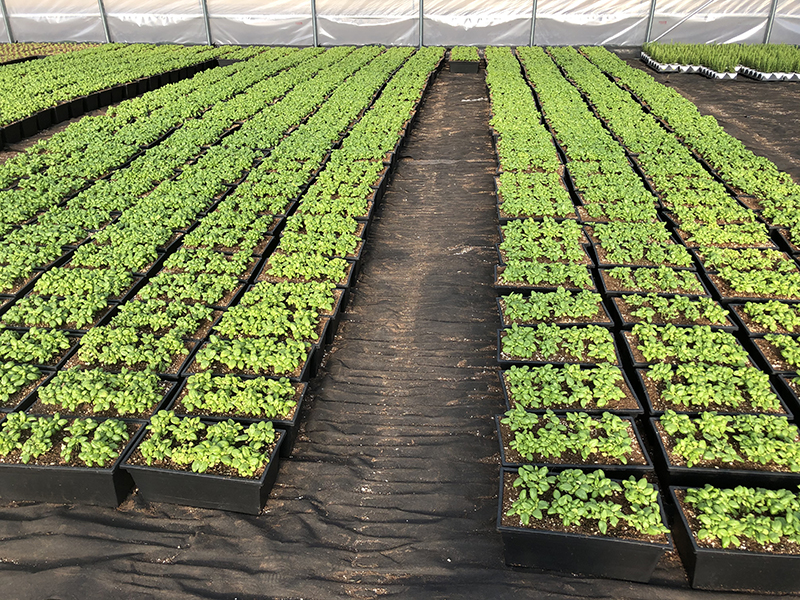Don’t Let Your Greenhouse Electrical System Come Up Short – Part 2
The size of a greenhouse operation is one of the biggest factors when determining the type of electrical system to install. In order to keep a greenhouse running smoothly, several considerations must be carefully thought out ahead of time. Part 1 of “Don’t Let Your Greenhouse Electrical System Come Up Short” covered choosing an electrician, meeting immediate and future needs and preparing for back-up power. Part 2 will cover locating electrical wires, meeting electrical load demands and environmental considerations.
Locating The Electrical Wires
One consideration when planning an electrical system for the greenhouse is the location of the electrical wires coming into the greenhouse.
“A grower is going to have to decide whether he wants the wires overhead or whether he wants below-ground wiring,” says Tom Manning, a project engineer at Rutgers University’s New Jersey Agricultural Experiment Station in New Brunswick, N.J. “That is going to depend on the location of the electric utility pole, the location of the main point of entry for the electric service and whether the grower is going to have to track down a problem with the wiring. If the wires are going to be buried, the grower usually has to bear the cost of the burial. The decision to bury the wires or to run them overhead is usually related to issues such as traffic, aesthetics and/or convenience.”
Manning says burying the wires isn’t usually an issue should a grower decide to expand the operation.
“When an expansion occurs, a grower doesn’t usually expand toward the power lines,” he says. “Anything that is buried between the greenhouse and the source of the power is probably going to be used as a parking area or located in an open area. It is not an area where building construction is going to occur. A grower can build over buried cables in some cases, but a greenhouse can’t be built under overhead electrical wires.”
Manning says in many commercial buildings the electrical wiring can usually be located throughout the facility.
“In a greenhouse the grower doesn’t want the conduit or the wiring to block the sunlight coming into the house,” he says. “This also applies to the location of the electrical panels. Some growers don’t want the panels mounted on the south wall of the greenhouse to prevent blocking the light. Also, panels should be located so that they don’t interfere with ventilation requirements. For example, it is better not to locate the panels on walls with continuous vent windows.”
Meeting Electrical Load Demands
One of the biggest electrical loads in a greenhouse is horticultural lighting, Manning says.
“If a grower is lighting an acre or 10 acres with high intensity discharge lamps, he needs to make sure that his electrical service can accommodate those fixtures,” he says. “The electric utility, lighting manufacturer and electrician can help a grower make those calculations.
“The second most common large electrical load is from coolers. A grower who is producing bulb crops or a crop like lettuce will need to use coolers. The cooler manufacturer should be able to assist with determining the electrical load for that equipment.”
Consider Humidity And Water
Another aspect of greenhouses that is different from other commercial buildings is the higher levels of humidity and water.
“Growers need to have the appropriate weather resistance in the panels and the parts that connect the panels to the conduit,” Manning says. “All of the electrical devices in the greenhouse have to be protected from moisture.”
Growers should also take temperature into consideration when installing an electrical system.
“PVC conduit should not be used in greenhouses,” Manning says. “It is subject to sagging under warmer temperatures. It also degrades under ultraviolet light so it breaks down over time. This also applies to PVC-outlet boxes and other electrical components.”
Romex flexible wire, which can be installed in residential dwellings, “has no place in greenhouses,” Manning says. “Most of the jackets for flexible wiring, including Romex, degrade under UV light. There are some flexible cables and outdoor-rated plugs that can be used with greenhouse grow lights and other equipment.”
Manning says cables for greenhouse equipment should be labeled SJOOW. Older designations that are no longer used, but are acceptable, include SJOW. Cables labeled UF-B are suitable for direct burial, but may not be appropriate in all cases and code restrictions may apply to their use.
Manning says a grower who is operating naturally ventilated greenhouses without horticultural lighting or any large coolers or motors should be able to run 10 acres on 200 amps.
“In these types of greenhouses, the irrigation pumps are likely to be the biggest draw,” he says. “Well pumps can be a significant electrical load if a grower is operating a deep well and needs to pump a lot of water. The well driller is going to know the pump size that is needed.”
Manning says the electrical load for most greenhouse equipment is intermittent.
“Transportable benches are very often pneumatically controlled and may have a drive motor on them,” he says. “They aren’t used that often so their contribution to the electric bill is relatively small. This also applies to material handling equipment and potting conveyors. Typically, the equipment used in the greenhouse has relatively small motors, and they operate on and off. This equipment usually doesn’t require a big load and makes a small contribution to the annual bill.
The other equipment that is going to be a significant portion of the electrical demand is circulating pumps for hot water systems, exhaust fans and fans for unit heaters.
“The electrical demand for operating the heating systems is often bigger than the material handling the equipment motors, and they often run more frequently, particularly circulating motors for hydronic heating systems,” he says. “Those motors may run 24 hours a day for six to eight months depending on the climate.”










